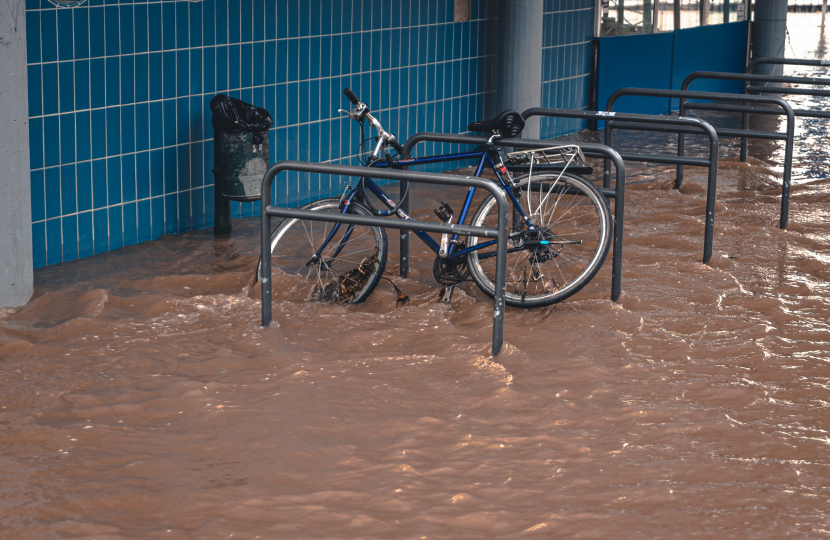
Felicity Buchan, the MP for Kensington, has written to residents updating them on the final stage of the London Flood Review into the July 2021 flooding. You can read the full text of her letter below:
Dear Resident,
As you may be aware, the London Flood Review has now published the final stage of its report into the West London flooding in July 2021. I have now read the report in full and will set out my thoughts below. Whilst I am very grateful for the work of Chair Mike Woolgar and his colleagues, I believe the report needed to go further in recommending significant infrastructure investment. You can read the full report here.
Since the publication of the report, I have met with the CEO of Thames Water, Sarah Bentley, and with councillors and council officials to discuss where we go from here. I look forward to challenging these stakeholders to deliver for residents at further meetings over the Summer and into the Autumn.
Infrastructure Investment
Thames Water has set aside £10 million for the installation of FLIP devices in at-risk properties. The Review identified that 1576 properties reported flooding, however I believe the actual number to be higher. There is a clear disparity here between the scale of the problem and the amount of money being put forward by Thames Water to deal with it.
FLIPs are fundamentally a short-term solution to a long-term issue. A review of flooding in the Counters Creek catchment area (the site of the proposed relief sewer that was abandoned by Thames Water) is due in July 2023, and by that time Thames Water must determine and then address the level of infrastructure investment required to minimise the risk of such an event happening again. Thames Water acknowledges this in its Drainage and Wastewater Management Plan (DWMP); it must step out of its regulatory cycle, which refreshes in 2025, and accelerate long term funding to make West London more resilient now.
Thames Barrier
The Thames Barrier takes 36 hours to close and is currently not closed for surface water flood events. The Review shows that the high tide had a significant effect on the flooding and that closing the Barrier would have alleviated this. I will be having conversations with the relevant authorities on how the Barrier could be used to aid in surface level flooding.
Pumping Stations
I know that many residents were concerned about the efficacy of the Pumping Stations at Hammersmith and Lots Road. The Review identifies that one of the eight pumps at Hammersmith did fail, however it still remained within its operating capacity. We need more clarity about why the pump failed and what Thames Water’s plan is to prevent a similar occurrence in the future.
Sustainable Drainage Systems
Sustainable Drainage Systems (SuDS) are one of the flood alleviation tactics considered in the report. These include nature-based solutions like more plants and soil, as well as ‘grey’ solutions like permeable pavements. I am supportive of suggestions that new or refurbished developments should have a duty to consider incorporating SuDS into their builds at the planning stage. It is however important that SuDS are considered alongside major infrastructure projects, not in lieu of.
Governance
The Review identifies a need for an integrated approach to managing flood events in London. In particular, it points out that the hydrological catchment boundary that covers most of the constituency also spreads into the City of Westminster, Brent and Hammersmith and Fulham. Flooding does not respect borough boundaries; we must ensure that all councils are working together to prevent flooding, and I am pleased that RBKC recognises this.
The report recommends that a single authority be set up to oversee surface water flooding strategy in London. This echoes a similar call from the Surface Water Flooding Task and Finish Group. This Strategic Group would be comprised of representatives from key stakeholders such as the local council, Environment Agency and Thames Water. This body would need to be backed by Government and local authorities, and have ultimate authority over flooding in London, providing a clear chain of accountability for residents.
Communications
I am pleased that the Review recognises that there were significant failings with Thames Water’s initial response to the flooding on 12th July and 25th July. On 12th July event specifically, it highlights that the increase in calls to Thames’ customer services at 16:30 coincided with a 40% reduction in staff as the day shift ended. The report recommends that agencies inform residents of extreme weather events in advance so they can prepare, and that processes are implemented to update key stakeholders as an event unfolds. Emergency communication channels should also be set up on an inter-agency basis to better coordinate support.
These are common sense answers to the significant failings we saw in the immediate aftermath of the floods. From my flooding survey, residents have clearly highlighted the need for improved communication from Thames Water in the event of further flooding. This was raised at my meetings with stakeholders last week; RBKC now have a heavy rain warning system that they will be able to share with residents, and Thames Water has identified and is actively working to improve its customer service.
Data
Real time data collection is happening in parts of our flood defence system, for example with the water level in certain parts of the sewer. However, this data is not being shared efficiently to enable all parts of our flooding response to work effectively. An effective data sharing agreement needs to be made between all key stakeholders so that real time data is available to provide the best possible emergency response.
Following a flood event, we also need to ensure that residents know how to report that their property has been flooded, and that this information is then shared among key stakeholders to ensure they receive the best possible support. A single online portal, along with a write-in option, would establish this and streamline the process of getting help after a flood event.
Conclusion
This report does not contain all the answers that Kensington needs. We now need action. My key asks are:
- Major investment for water infrastructure in West London.
- Installation of SuDS and FLIP devices to be sped up and deployed in areas that were flooded in 2021.
- A clear communications strategy during and after a flood event for informing residents and key stakeholders.
- A single Strategic Body responsible for flood response and alleviation.
To achieve this, I will be:
- Meeting with RBKC, Thames Water and members of the London Flood Review to challenge them to deliver for residents.
- Arranging a ‘town hall’ style meeting in the Autumn with key stakeholders and residents.
I am determined that we must minimise the risks of flooding going forward.
Yours faithfully,
Felicity



